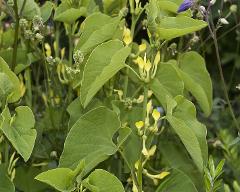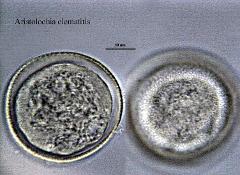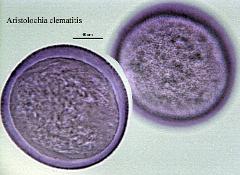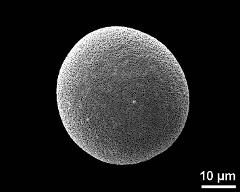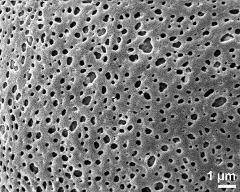Aristolochia clematitis
Taxonomy: Angiospermae, Piperales, Aristolochiaceae, Aristolochia
Links: http://flora.nhm-wien.ac.at/Seiten-Arten/Aristolochia-clematitis.htm
Published: 2020-10-06
Pollen Description
Shape, Size and Aperture
pollen unit: monad, dispersal unit and peculiarities: monad, size (pollen unit): medium-sized (26-50 µm), size of hydrated pollen (LM): 41-50 µm, shortest polar axis in equatorial view (LM): -, longest polar axis in equatorial view (LM): -, shortest diameter in equatorial or polar view (LM): 36-40 µm, longest diameter in equatorial or polar view (LM): 41-50 µm, pollen class: inaperturate, polarity: -, P/E-ratio: -, shape: spheroidal, outline in polar view: circular, dominant orientation (LM): polar, P/E-ratio (dry pollen): -, shape (dry pollen): spheroidal, outline in polar view (dry pollen): circular, infoldings (dry pollen): not infolded, aperture number: none, aperture type: no aperture, aperture condition: inaperturate, aperture peculiarities: -
Ornamentation and Structure
LM ornamentation LM: scabrate, gemmate, verrucate, nexine: -, sexine: -, SEM ornamentation SEM: perforate, suprasculpture SEM: -, TEM tectum: -, infratectum: -, foot layer: -, endexine: compact-continuous, intine: bilayered, wall peculiarities: -, supratectal element: -
Miscellaneous
pollen coatings: pollenkitt, reserves in cytoplasm: -, cell number: -, Ubisch bodies: present
Annotations: shape in hydrated condition: spheroidal to ovoid;
Author(s) of diagnosis: Hesse, Michael; Halbritter, Heidemarie; Heigl, Helmut
Pictures
Picture legend
- habitus, photographer: Buchner, R.
- flower(s), photographer: Halbritter, H.
- flower(s), photographer: Buchner, R.
- hydrated Pollen - fresh, glycerine, unstained, photographer: Heigl, H.
- hydrated Pollen - fresh, glycerine, ruthenium red, photographer: Heigl, H.
- hydrated Pollen - fresh, glycerine, ruthenium red, photographer: Heigl, H.
- hydrated pollen grain - fresh, rehydrated (water) & critical point dried & sputter coated with gold, photographer: Halbritter, H.
- exine surface - fresh, rehydrated (water) & critical point dried & sputter coated with gold, photographer: Halbritter, H.
- dry pollen grains - dry, sputter coated with gold, photographer: Halbritter, H.
- exine surface of dry pollen grain - dry, sputter coated with gold, photographer: Halbritter, H.
- pollen wall - fresh, glutaraldehyde & osmium, uranyl acetate & lead citrate, photographer: Hesse, M.
- pollen wall - fresh, glutaraldehyde & osmium, uranyl acetate & lead citrate, photographer: Hesse, M.
Literature
- (1998) Preparing living pollen material for scanning electron microscopy using 2,2-dimethoxypropane (DMP) and criticalpoint drying. Biotechnic Histochem 73: 137–143
Copyright and Citation
Cite this publication as:
Hesse M., Halbritter H., Heigl H., Buchner R. 2020. Aristolochia clematitis. In: PalDat - A palynological database. https://www.paldat.org/pub/Aristolochia_clematitis/303787; accessed 2024-10-31

